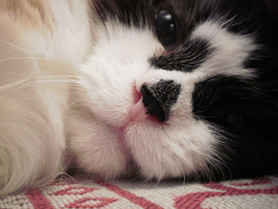PET RELOCATION & QUARANTINE ALTERNATIVE
La Rouillardais is Pet Friendly and offers assistance with Pet Relocation for EU and Non-EU citizens.
|
For an overwhelming number of families, the decision to emigrate is often made all the more difficult because of the red-tape involved bringing their beloved pets along for the journey. And for many, the decision to emigrate can often mean the decision to leave those little family members behind - or being separated from them for as long as six months during mandatory pet quarantines. Both instances can prove to be deal-breakers, or at the very least, traumatic for all involved. But there is an alternative, and for those wishing to relocate to Europe, France offers that alternative. Travelling to France with pets does not require a mandatory quarantine period. While there is indeed a significant amount of preparation and paperwork that must precede entry into France, the heartache that emigration often involves can be avoided. The quarantine period required for entry into most European countries can be spent in France. No cages. No separation. PlanningThe rules concerning pet entry into France will vary according to the country of departure, and just the same, your country will stipulate its own requirements concerning departure with pets. It is important that you do your research concerning the necessary regulations, well in advance to your planned trip.
In all cases, pets must be micro-chipped before ANY other procedures. This micro-chip serves as a record of all subsequent procedures; without it, any vaccinations are considered null and void. The next most important procedure is the rabies vaccination. Again, specifics concerning time-frames will vary according to the country of origin, but in most cases, it is a lengthy business, and the waiting period between vaccination and titre tests, as well as between titre test and actual departure, must be factored into your planning. This process alone can take at least four months. Make sure that the steps concerning the rabies vaccination and test are followed to the letter. A minor error, particularly concerning time-frames, can result in having to repeat the entire process again, inevitably wreaking havoc with your travel plans. Tick and tapeworm treatments are also advisable, if not required, prior to travel. The most important piece of documentation, alongside the rabies titre-test results, is the EU998 form, which is essentially a health declaration. While this form can be completed any time up to four months before travel, in practice, however, it is usually done the week before travel. The form is filled in by your own family veterinary surgeon, after having examined the pet. The form is then countersigned by your State Vet. In some countries any qualified vet is an "official veterinarian" and the countersigning endorsement is not required. But this is not always the case. For the most recently updated EU pet travel regulations, visit the DEFRA(Department for Environment and Rural Affairs) webpage. Getting thereAnother concern for pet-owners is the actual transport from point A to point B. For certain animals (and certain airlines), flying in the cargo carrier of the airplane is not the only option. Subject to your pet's weight (approximately between 6kgs and 8kgs), flying in-cabin is a potential alternative. Again, this is a route that needs to be researched thoroughly - airline regulations change frequently, and airline websites may not always advertise the in-cabin pet travel option. It must be made mention of the fact that pets will understandably be frightened during the flight, and this can often be stressful for the owner to deal with. Travelling with pets in-cabin also significantly limits the amount of cabin-space available. On both counts, however, it often remains preferable to endure such temporary discomfort for the sake of peace of mind, by being able to keep an eye on the loved one (and give much-needed comfort) during the flight. For those who would prefer in-cargo transport of their pets, it is vital that the airline staff and crew are reminded of your precious cargo's presence within the hold. There are also of course a number of pet transporters, who will take care of your pet's journey, from preparation to landing. Whichever choice you make, do consult your vet before travel. There are a number of natural calming aids that can make the trip easier on the pet. Sedation is NOT an option. It is also important to note that airport staff may insist on scanning the animal, and checking the carry-bag. Make sure your pet is securely restrained, and if at all possible, request that you be the one to handle the pet, not a stranger. There are a range of comfortable pet carry-bags and crates at Pet Travel that meet standard airline requirements for both cabin and cargo travel. ArrivingIf your country of origin is not a listed country (Qualifying European Union (EU) countries and territories, Qualifying non-European Union countries and territories), as soon as possible, find a vet and have your pet re-vaccinated for rabies. This is because certain countries will not accept any vaccinations as valid that were carried out outside the listed countries. The vet will issue a PETS Passport at this point. This is another very important document, and must accompany the pet for all vet visits and travel. Always ensure that any information recorded in the passports is correct, particularly times and dates of vaccinations. You then repeat the titre test. Most vets in France will insist upon waiting 30 days. There are several good, approved laboratories in France. One hint: try to get the vet to draw two samples from your pet. He'll send one off, and keep the other in his fridge. If the first goes missing, or gets contaminated, you can submit the second without time penalty [remember, it's the date that the serum is drawn, not analysed, that is the trigger date]. Please be aware that for certain animals, the French vets while anesthetise them. Your pet will experience dramatic mood swings during the period that it recovers from the anaesthetic. This can take anything from 4 hours to 24 hours. Be prepared. Following the necessary quarantine time period (specific to each EU country), after the date upon which the blood was drawn, your pet can enter your chosen immigration destination. Between 24 and 48 hours before embarkation, they need a medical fitness certificate (i.e. "fit to travel") in their passports, and repeat tick & tapeworm treatment. Try to avoid travel on a Monday (vets are shut on Sundays), or the day after bank holidays. AccommodationOnce you have landed with your precious cargo, it is a matter of finding accommodation for the required quarantine period that will accept both you and your pet. This is where pet-friendly La Rouillardais comes in. Guests can enjoy the tranquil splendour of Northern France - and their pets can too - with over five acres of private garden. Avid animal-lovers Denise and Laurence Dealtry are experienced in the pet-transition procedures, and shall be pleased to assist the pet-owner and pet throughout their stay. ReferencesManson, Ozzy, Litchi, Nermil and their owners (Alastair and Cherise), stayed with us for a period of 8 months in 2010. They completed their stay in February 2011. Here are some comments from them as well as some images:    
"We would like to thank you for all the support and help that you gave us during our stay, from taking us to the vet to providing us with a safe garden for us to play in. We thank you very much, Laurence and Denise. We will never forget you." With love, Manson, Ozzy, Litchi and Nermil. For booking and other enquiries Click Here. |
Web links
EU998 form in English from Classy Pets |